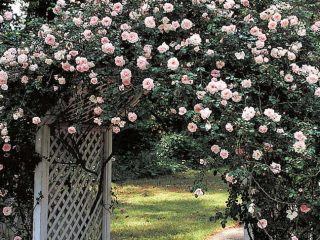Content
Lilies are deservedly popular among gardeners, second only to roses. After all, they are characterized by sophistication, long flowering, require little space and minimal care. Moreover, not only a professional, but also a beginner can cope with growing this crop. However, it is worth considering that lilies bloom only under favorable conditions. Therefore, you need to familiarize yourself in advance with the possible reasons for the lack of buds, as well as the actions that need to be taken in this case.
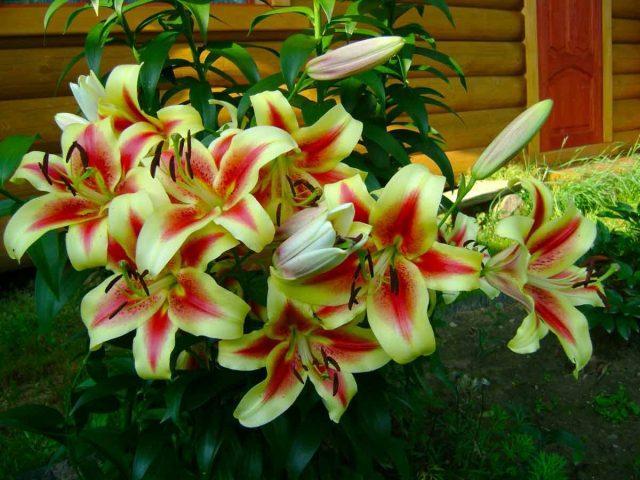
With proper care, garden lilies bloom every year
In what month does the garden lily bloom?
The flowering period of a lily directly depends on the type of crop. The tiger varieties are the first to form buds. They bloom already at the end of June. Then, after about two weeks, buds appear in the Asian species. Subsequently, LA hybrids and trumpet lilies bloom at the same interval. And only in August buds are formed in the eastern species.
And for some of them this period continues until the beginning of September.The flowering time of lilies may shift slightly, depending on the growing region and weather conditions.
How long does it take for a lily to bloom?
The flowering time of this perennial is 17-20 days. Moreover, it does not depend on the type of culture. Each flower remains decorative for 3-9 days. The plant is well suited for cutting and all its buds open in water.
Lily blooms once per summer. And even with timely removal of faded buds, it is impossible to force the perennial to form them again within one season. This is due to the fact that the formation of flower buds in garden lilies occurs only in the fall.
Why do lily buds not bloom?
Bulbous perennial belongs to the category of unpretentious crops. However, sometimes some gardeners are faced with the problem that the lily does not bloom for several years. This can happen for a number of reasons, so it is worth considering the main ones so that, if necessary, the true one can be determined by elimination.
Poor quality bulbs
The lack of buds is most often associated with the purchase of low-quality planting material. The bulbs should be dense, elastic and have no signs of rot or mold on the bottom. Otherwise, they will not be able to fully develop and bloom accordingly.
The reason may also be improper storage of the bulbs after digging. Experienced gardeners recommend storing planting material in a plastic bag with wet peat or sawdust and holes for unhindered air circulation at a temperature of +2-6 °C. Therefore, the best option may be a refrigerator in the basement.
Sometimes the problem occurs when the baby bulbs are separated. In this case, flowering can be expected only after their diameter reaches at least 5-6 cm. And before that, the plant will build up the underground part for several years.
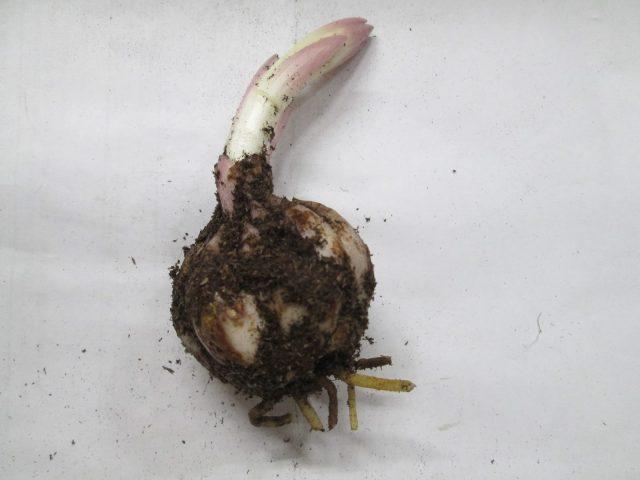
The perennial bulb forms one peduncle
Bad location and neighbors
This crop is demanding in terms of light levels, so planting it in the shade is unacceptable. It is recommended to plant garden lilies in an open sunny place. But it is also possible to place them in partial shade. However, in this case, the duration of flowering of lilies will be longer, but the color will be less bright.
The problem arises when planting a perennial next to tall crops that have an extensive superficial root system. With this proximity, garden lilies lack moisture and nutrients, and as a result, there is no flowering.
Unsuitable soil
This plant prefers loose soil with good moisture and air permeability. It is important that the soil is neutral. Experienced gardeners recommend planting lilies in loam and sandy loam soil.
If humus has recently been added to the site, lilies should not be planted. This is due to the fact that this perennial reacts poorly to organic matter. Therefore, it is recommended to wait 1-2 seasons, and then you can transfer the lilies to this area.
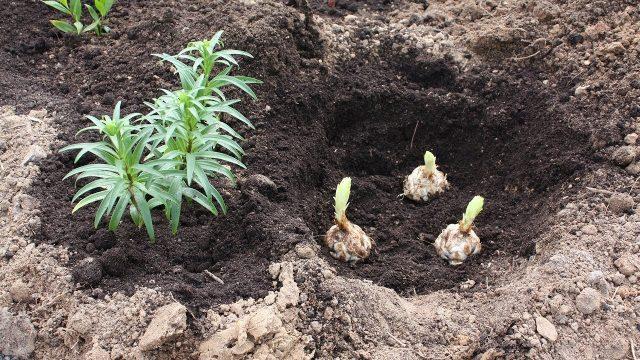
Recommended planting depth is three times the diameter of the bulb.
Late transplant
This crop can grow in one place for 4-5 years. After this time, it is recommended to replant it, as the decorative effect decreases and there may be no flowering. This occurs due to the growth of baby bulbs around the mother plant, which become crowded.
Transplantation should be carried out in the fall, namely at the end of September. But it is important that at least three weeks remain before the onset of frost. This time is necessary for full rooting of the bulbs. Delaying the timing of transplantation does not lead to the death of the plant, but may cause the lilies to not bloom in the next season.
Errors when feeding
This perennial needs regular feeding throughout the growing season. It is recommended to fertilize it four times, which guarantees abundant, long-lasting flowering in the current and future seasons.
It is necessary to feed lilies for the first time at the beginning of growth with nitroammophos at the rate of 30 g per 10 liters of water. And then every three weeks, using 40 g of superphosphate and 25 g of potassium sulfide for the same volume of liquid. In the absence of these fertilizers, wood ash can be used to feed garden lilies. To do this, you need to pour 200 g of the component into 1 liter of hot water, mix and leave for a day. After time, the volume of liquid must be increased to 10 liters and watered over the lilies. The consumption rate of the nutrient solution is 0.5 liters per plant.
Incorrect pruning
Lack of flowering is often associated with the early removal of faded flower stalks. After all, they are a source of nutrition for the bulbs. The longer the flower stalks remain green, the more luxuriantly the garden lilies will bloom in the coming season.
During the season, it is recommended to trim only leaves that have lost their decorative properties. Peduncles can be removed only after they have completely dried out.
Diseases and pests
Lilies do not form buds even when affected by diseases.Lack of flowering can be caused by rosette and penicellosis. In the first case, the stem of the plant thickens and turns yellow, and in the second, rotting of all parts of the perennial is observed.
Lack of flowering in garden lilies is often observed when attacked by pests such as spider mites, squeak beetles, mole crickets, beetles, and lily flies. In this case, the plant cannot fully develop, has a dejected appearance and does not form buds.
What to do if the lily does not bloom
If a lily does not bloom, you must first determine the reason and only then correct the situation. If the location for the perennial is unsuccessful, it should be replanted. Asian species can be transferred to a new place throughout the summer if there are favorable weather conditions, while the rest can be transferred better in the fall, otherwise the underground part will not be able to accumulate enough nutrients.
If there is no flowering due to planting in unsuitable soil, it is recommended to mix sand and wood ash into the soil to the depth of the bulb. This must be done carefully so as not to damage the roots.
To ensure annual flowering and preserve their decorative properties, it is necessary to replant garden lilies to a new location after 4-5 years. In this case, the procedure must be carried out in advance. It is also important to take into account the requirements of the plant when feeding it.
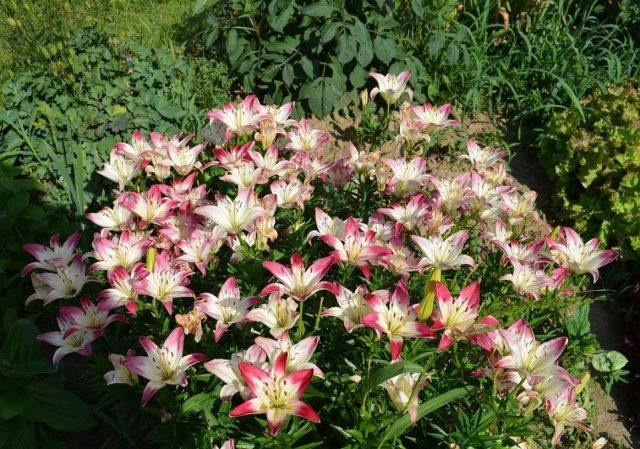
Asiatic lilies are the easiest to care for.
For abundant annual flowering, the lily must have a supply of nutrients in the bulb. Therefore, after the buds wither, there is no need to cut off the stem, because it is this that helps the plant accumulate the necessary components.
If alarming signs of disease appear, it is recommended to dig up the bulbs, clean them of affected scales and treat them with Maxim fungicide.If a perennial is damaged by pests, it is necessary to spray the stem and leaves with Fitoverm, and also water it with Aktara solution.
Conclusion
If lilies bloom sparingly or do not form buds at all, then urgent measures must be taken to correct the situation. This is mainly due to mistakes made in care, during planting, or incorrect placement of the perennial on the site. Therefore, the sooner the cause is identified, the faster the plant will recover and enjoy prolonged flowering.


